Understanding the ANSI five-foot ceiling height rule for measuring rooms with sloped ceilings.
Okay, we’ve all seen plenty of rooms with sloped ceilings and most real estate professionals assume they know how to measure this space accurately. However, after discussing this topic in over forty states, there is obviously NOT one industry-wide accepted method for measuring these rooms/spaces. It’s a discussion that the real estate industry needs to resolve, and now. Consumers deserve to know the one, true size of their homes; and right now the size of any single-family home may depend on who measures it and where you live. If the real estate business is going to use a price-per-square-foot formula to calculate home values, then there needs to be an agreement on the definition of calculating a finished square foot. There is less information available on measuring square footage than any other subject in the industry. When asked about measuring rooms with sloped ceilings, “it depends” was frequently part of the answer by most agents. In determining the value for your single, largest, lifetime investment, “it depends” is certainly not something you want to hear.
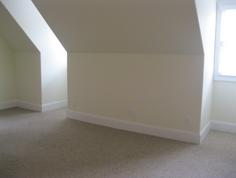
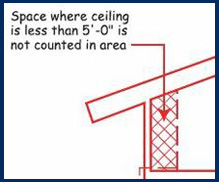
According to the ANSI Guideline, to be included in the finished square footage count, rooms/spaces/areas are supposed to have a ceiling height of at least seven feet for over half of the space, and no portion of the finished area can have a ceiling height of less than 5 feet. It looks pretty simple, and at first glance many of us assume the measurement would start (and stop) when you reach the five foot mark on any sloped ceiling. The image below is a small portion of a sketch used in the ANSI® guideline and clearly states that any space below five feet is not counted in the finished living area.
In another section of the Guideline, it states that finished measurements should be taken to the “exterior face.” In other words, if you were going to make a calculation from an interior measurement, you would normally add for the width of the exterior walls. It’s very clear in all measurement publications that finished space is measured from the exterior dimensions. You include the exterior walls in your measurements. Whether it’s a brick wall, stone, vinyl, aluminum, cement fiberboard, cement block, or any other exterior siding; you measure finished square footage from the outside corner of the dwelling.
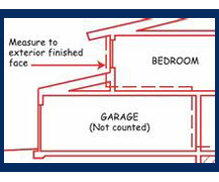
Okay, here is where it gets interesting. Do you add six inches (or five-tenths of a foot) for the width of exterior walls when you measure rooms with sloped ceilings? Guess what – it depends…
The rules of measurement say to always measure finished space using exterior dimensions. When agents and appraisers measure upper level living areas (using interior measurements), they simply add six inches (or five-tenths of a foot) for each exterior wall. If the inside of a finished bonus room measures 14.4 x 21.0, the actual finished calculation would reflect 15.4 x 22.0, adding five tenths of a foot (or 6 inches) for each exterior wall. Look at the sketch below.
In this example, the interior measurements are 14.4 x 21.0 or 302 sqft. The correct measurements should include the width of both exterior walls.15.4 x 22.0 or 339 sqft (plus the addition of the staircase dimensions 8.0 x 4.0). If the length measurement of the room interior is 21.0, then the correct total would be 22.0. The width measurement of 14.4 would be 15.4; adding five tenths of a foot for each exterior wall. A difference of 37 square feet on a simple bonus room.
So, what’s the big deal about only 37 sqft? Using an example of $130.00 per-square-foot, the difference would be 37 x $130.00 or $4,810. Don’t think that matters? Get out your checkbook…
Measuring square footage is an “art” and will never be an exact science. And, the possible configurations and designs of rooms with sloped ceilings is almost unending. There are literally thousands upon thousands of different designs and layouts of rooms/areas/spaces that have sloped ceilings. However, for a measurement that occurs in homes all across America (and the world), the real estate professionals need to agree on how they are going to measure this space and exactly what is included within the “finished square footage.” There must be one “rule” for measuring rooms with sloped ceilings, that explains the full measurement. Ask your agent or your appraiser how they measure rooms with sloped ceilings.
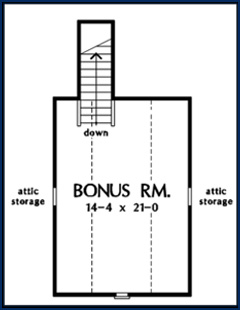
So, we have one theory or method that says since all other measurements for upper level living spaces include the width of exterior walls, then so should the measurement of rooms with sloped ceilings. At the five-foot mark on any sloped ceiling, they add five-tenths of a foot for each exterior wall. They treat sloped ceilings just like all other upper level measurements.
The second theory or method says that the measurement for rooms with sloped ceilings stops at the five-foot mark on the sloped ceiling, WITHOUT the addition for the width of any exterior walls.
Doesn’t sound that like big of a deal until you measure a large bonus room or any room with sloped ceilings and add an extra foot to each measurement.100 (plus) square foot differences are common. Multiply that times anywhere from $60.00 to $130.00 (or a whole lot more) per-square-foot and we’re talking real money. Not only is the money issue a very big deal, but just the fact that the “experts” can’t agree on how to measure this space is unfair to buyers and sellers.
I’m often asked how I measure rooms with sloped ceilings. In my opinion, the best method is the way listed in the American Measurement Standard®. I measure to the beginning of the five-foot height point on the sloped ceiling and measure to the opposite point on the other side of the room; WITHOUT the addition for the width of the exterior wall(s). This measurement provides the only exception to the “rule” when it comes to measuring finished space from exterior dimensions. By trying to add the six inches to every sloped ceiling, the measurements end up being less accurate and far too difficult to produce consistently. Ten different real estate professionals may come up with ten different square footage totals. I believe the best way to measure square footage is the way that provides the most consistent (and reproducible) calculations. So, when I reach the five foot mark on a sloped ceiling, that where the buck stops.
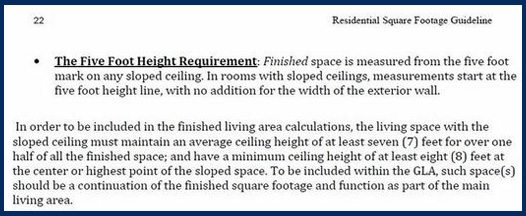

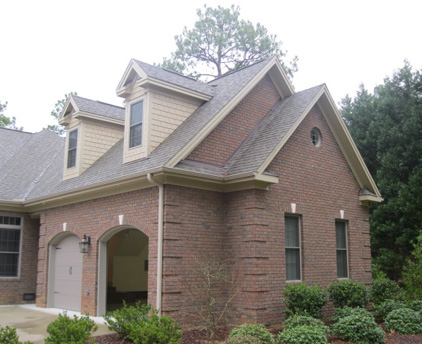
Often, the answer to this question depends on who you ask. The ANSI® measurement guideline explains “most” of this measurement issue. However, it does NOT explain it all. The part that is left unexplained causes confusion and debate among agents and appraisers. Each real estate professional believes their method is the “right way.” And, without a universally accepted written standard on this one key issue, no one can absolutely say their way is the only way to measure rooms with sloped ceilings. This should be a very simple discussion. But, the rules of ANSI® leave this measurement just short of a full explanation. If you’re brave enough to ask real estate professionals in different parts of the country about this measurement, be prepared; you may get some very strong opinions. There is definitely no lack of opinions on measuring square footage. I see this issue just like the speed limit. What’s a fair limit on a wide-open highway in the middle of nowhere? 55-60-70? What’s fair? There may never be an absolute agreement on certain issues, but someone has to set the rules or standards for others to follow. That’s just the way our system works. There must be the same limits for square footage, just like there are for speed limits. It’s time for the real estate industry to join the rest of the standardized world.
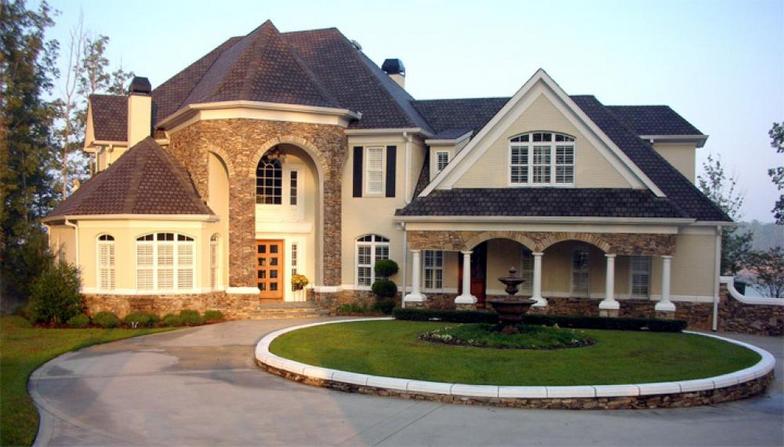
For consumers, does this really make any difference. Once again “it depends.” However, if my house was valued at $130.00 per-square-foot, and I had two licensed appraisers give me different totals (142 square feet apart), I want someone to explain to me why. Let’s see, 142 sqft times $130.00 per-square-foot equals about $18,460. OMG! It certainly just grew in importance to me. Got an extra fifteen or twenty grand laying around?
This is one debate that it’s time for the real estate industry to answer. There is one possible answer in the American Measurement Standard®, but it is still not recognized by many industry leaders. Even though this method has been in use over a century, it was unwritten prior to 2009 and there is still no one in the real estate or appraisal industries who wants to let this cat out of the bag. They are afraid to open the Pandora’s Box and let the public know just how unscientific measuring residential square footage is. The commercial side of the industry has seven measurement standards, yet the residential side still struggles with two; even though they have both been around over a century. They only trust the name they know, even though a large majority do not know the actual rules of the standard they claim to follow. It’s just not a topic anyone wants to talk about, and with good reason. There are no simple solutions.
It’s time for the real estate industry to stop working on appraisal reform (which has done nothing to help our national real estate situation), and get back to basics. Basics that start with each listing agent and measuring the house (or having it measured). We work in a price-per-square-foot world and it’s time to decide on one, nationally mandated method of how to calculate one square foot. Consumers deserve to know.

